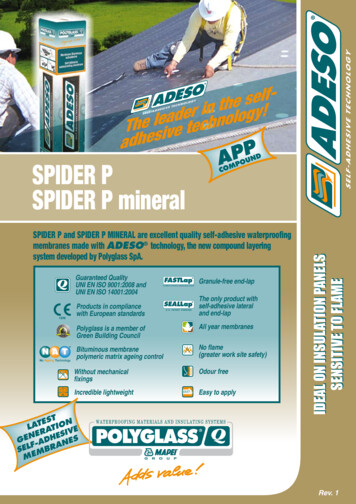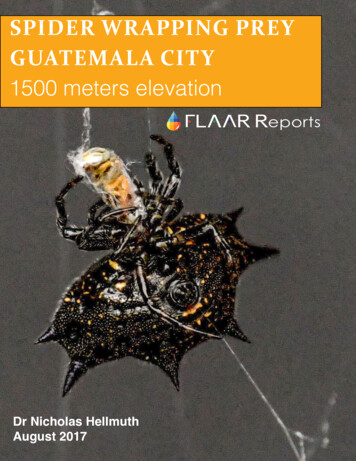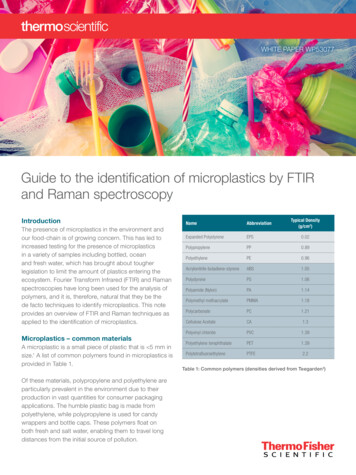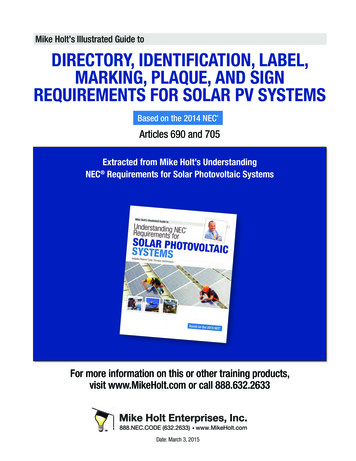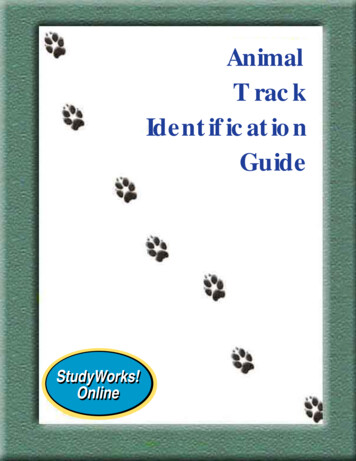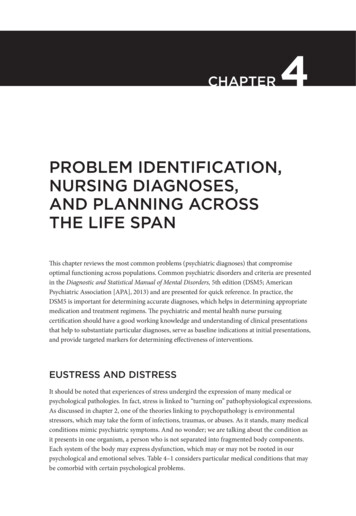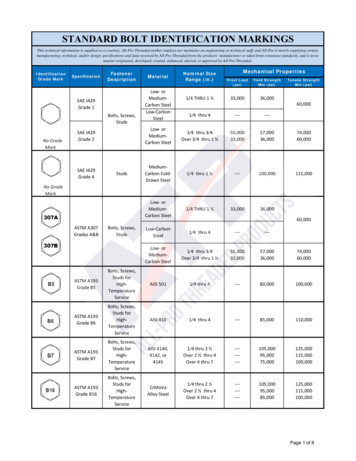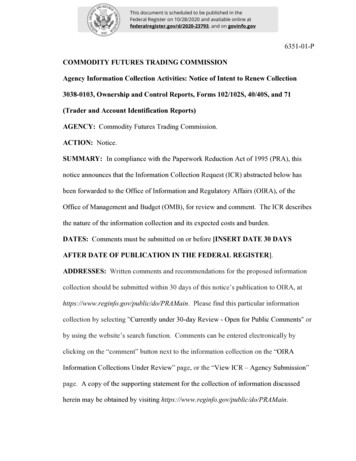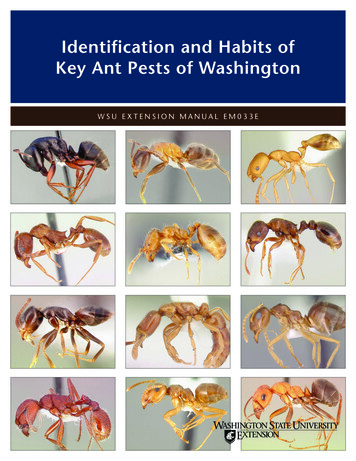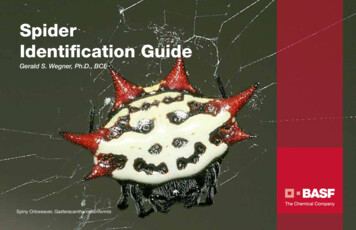
Transcription
SpiderIdentification GuideGerald S. Wegner, Ph.D., BCESpiny Orbweaver, Gasteracantha cancriformis
Table of ContentsSpider Facts: Frequently Asked Questions. . . . . . . . . . . . 3-4Jumping Spiders. . . . . . . . . . . . . . . . . . . . . . . . . . . . . . 28-29Spider Anatomy. . . . . . . . . . . . . . . . . . . . . . . . . . . . . . . . . . . 5Wolf Spiders . . . . . . . . . . . . . . . . . . . . . . . . . . . . . . . . . 30-31Spider Key. . . . . . . . . . . . . . . . . . . . . . . . . . . . . . . . . . . . . 6-7Wandering Spiders . . . . . . . . . . . . . . . . . . . . . . . . . . . . 32-33Spider Management In and Around Buildings . . . . . . . . . 8-9Nursery Web Spiders. . . . . . . . . . . . . . . . . . . . . . . . . . .34-35Hackledmesh Spiders. . . . . . . . . . . . . . . . . . . . . . . . . . 36-37SpidersCrevice Weavers. . . . . . . . . . . . . . . . . . . . . . . . . . . . . . 38-39Identification, Distribution, Biology and Pest StatusFunnelweavers . . . . . . . . . . . . . . . . . . . . . . . . . . . . . . . 40-41Cobweb Spiders/Combfooted Spiders. . . . . . . . . . . . . 10-11Cell Spiders & Tube Spiders. . . . . . . . . . . . . . . . . . . . . 42-43Hourglass Spiders/Widows. . . . . . . . . . . . . . . . . . . . . . 12-13Tarantulas/Hairy Mygalomorphs. . . . . . . . . . . . . . . . . . 44-45Cellar Spiders . . . . . . . . . . . . . . . . . . . . . . . . . . . . . . . . 14-15Orbweaver Spiders. . . . . . . . . . . . . . . . . . . . . . . . . . . . 46-47Brown Spiders/Violin Spiders. . . . . . . . . . . . . . . . . . . . 16-17Garden Spiders. . . . . . . . . . . . . . . . . . . . . . . . . . . . . . . 48-49Running Crab Spiders/Bark & Flower Crab Spiders. . . 18-19Longjawed Orbweavers & Orchard Orbweavers. . . . . . 50-51Giant Crab Spiders. . . . . . . . . . . . . . . . . . . . . . . . . . . . 20-21Nephilid Orbweavers. . . . . . . . . . . . . . . . . . . . . . . . . . . 52-53Sac Spiders. . . . . . . . . . . . . . . . . . . . . . . . . . . . . . . . . . 22-23Biography/Acknowledgements. . . . . . . . . . . . . . . . . . . . . . 54Ghost Spiders. . . . . . . . . . . . . . . . . . . . . . . . . . . . . . . . 24-25Photography Credits/References & Resources. . . . . . . . . . 55Ground Spiders. . . . . . . . . . . . . . . . . . . . . . . . . . . . . . . 26-27
Spider Facts: Frequently Asked QuestionsHow do spiders differ from other arthropods? All spiders have two body regions (cephalothorax and unsegmented abdomen), eight legs (each with seven segments),a pair of pedipalps, a pair of chelicerae (jaws) and either six or eight simple eyes.Are all spiders poisonous? Yes - to their prey! All spiders have a pair of poison glands with ducts that supply venom to the hollow jaws(chelicerae). Spiders inject venom and/or digestive juices into live or recently-killed prey in order to feed. Relatively fewspiders are dangerous to humans.Are harvestmen (garden daddy-long-legs) spiders? No. Harvestmen, or garden daddy-long-legs (Order Opiliones), have three broadly-joined body regions (head, thorax,and a segmented abdomen), one pair of eyes and are non-venomous. They feed on vulnerable insects and plant juices.How many different spiders are there worldwide?Over 37,000 species of spiders have been described worldwide.How many species of spiders are found in North America north of Mexico? Nearly 1,000 species of spiders have been found in the continental U.S. and Canada, many of which were introducedfrom Europe.What is the largest spider? The world’s largest spider is the South American goliath bird-eating spider, Theraphosa leblondi (Mygalomorphae:Theraphosidae). Adults may attain a body length of 4.8 inches (12 cm), a leg span of nearly 13 inches (30 cm) and abody weight of 5.6 ounces (160 g).What is the smallest spider? The smallest spiders on record belong to the Family Symphytognathidae. Anapistula caecula (Ivory Coast, West Africa)females have an adult body length of 0.018 inches (0.46 mm); while Patu digua (Columbia, South America) males havean adult body length of 0.015 inches (0.37 mm).3
Spider Facts: Frequently Asked QuestionsHow well can spiders see? All spiders have simple eyes. Most spiders have poor vision – merely able to distinguish light from darkness and nearbymovement. However, some (e.g., jumping spiders) have excellent short-range vision and are able to distinguish shape and color.Which spider’s venom is the most dangerous? The bite and venom of the Sydney funnelweb spider, Atrax robustus (Mygalomorphae: Hexathelidae), of Austrailiais considered to be one of the most life-threatening. Some sources claim that certain Brazilian wandering spiders,Phoneutria species (Araneomorphae: Ctenidae), have the world’s most toxic spider venom.How can you distinguish between female and male spiders? Most female spiders have a copulatory portal called an epigynum, uniquely-shaped for each species, located centrallyon the underside of the abdomen. Males have (species-unique) pedipalps with enlarged tips, giving them a boxing gloveappearance. Females generally have larger bodies (especially abdomens) than males. Males of some families have thefirst pair of legs longer and/or more stocky and hairy in proportion to their size.Do all spiders spin webs? Not all spiders spin webs for the purpose of capturing prey. Spiders may capture prey in three distinct ways: (1)ensnarement, assisted by a silken web comprised in part of sticky strands, (2) active hunting, while roaming about andexploring their surroundings, and (3) passive hunting – concealed or stealthily awaiting the approach of unwary prey.How do spiders get on the roofs of tall buildings? In order to disburse themselves from the egg sac, newly-hatched spiderlings of some species (e.g., orbweavers) maketheir way to an exposed perch and spin out long strands of silk, with which to catch a breeze. The airborne spiderlings“balloon” on air currents and updrafts until stopped by an obstacle. The first webs are constructed near the landingpoint, which may be miles away from and a considerable distance above, the point of origin.How long do spiders live? Some spiders live only one year (e.g., orbweavers), others may live two years (e.g., wolf spiders, nursery web spiders)and still others may survive into their twenties (i.e., some female tarantulas).4
Spider AnatomyPoison GlandsEyeAttachmentof PedicelHeartDigestiveCaecaAortaOvaryAnal estineFangEndite ofMaxillaTrochanterof PedipalpCephalothoraxCoxae of Legs(of Females)Book LungCoverSilkGlandsBook LungOpenAbdomenAdapted from Levi and Levi, 19905
Illustrated Key to Peridomestic Spider FamiliesChelicerae open and closedirectly forward and downwardChelicerae open and closelaterally and inward - scissors-likeMYGALOMORPH SPIDERSSuborder MygalomorphaeTRUE SPIDERSSuborder AnaneomorphaeEyes arranged in twogroups of threeEight eyesSHORT-BODIEDCELLAR SPIDERSPholcidae in partEight smalleyes clustered at topfront of carapaceSome eyes clusteredor groupedEyes distinctlyseparatedTRAPDOOR SPIDERSCtenizidaePosterior median eyesseparate; lateral eyesgrouped or closeContinue onpage 7FOLDING DOORTRAPDOOR SPIDERSAntrodiaetidaeAnterior medianeyes separateTARANTULASTheraphosidaeCribellum not presentLateral eyes grouped only;abdomen pot-bellied, globular,or spiny and extending overthe cephalothoraxAbdomen, legs and jawselongated; abdomen often withsilver background colorationLONGJAWEDORBWEAVERS &ORCHARD ORBWEAVERSTetragnathidae & NephilidaeLONG-BODIED CELLAR SPIDERSPholcidae in partWeb irregular-shaped6Eyes arranged in threegroups of two (diads)Cephalothorax circular &domed posteriorly; body& legs mottled, spottedor solid-coloredSPITTING SPIDERSScytodidaeCephalothorax notdomed posteriorly;abdomen and legssolid-coloredAnterior median eyes grouped orcloser than poster median eyesOne pair of eyesmedially; two groupsof three eyes laterallyCOMBFOOTED/COBWEB SPIDERS,INCLUDING HOURGLASS SPIDERSTheridiidaeSix eyesWeb orb-shapedORBWEAVERS &GARDEN SPIDERSAraneidaeLegs glossyred or brownLegs brown andnot glossyCELL SPIDERS &TUBE SPIDERSDysderidae & SegestriidaeBROWN SPIDERS/VIOLIN SPIDERSSicariidaeCribellum present;abdomen oval andnot extending overcephalothoraxHACKLEDMESHWEAVERSAmaurobiidae
Eight eyes distinctly separated (continued from page 6)All eyes appearclose in sizeEyes arranged intwo rows of fourCephalothorax and legsusually not hairy but have aslightly glossy or translucentappearance; spinnerets shortSAC SPIDERSClubionidae, Miturgidaeand CorinnidaeSome eyes distinctlylarger than othersLateral eyes noticeablylarger than median eyes;legs curve forward;adults typically largeEyes arranged in flat oval orsideways “D” patternTwo front pairsof legs curveforward; two rearpairs of legs curvebackward while atrest; one pair oflong spinneretsThree or fourpairs of legs curveforward while at rest;spinnerets very shortGIANT CRAB SPIDERS/HUNTSMAN SPIDERSSparassidaeAnterior eyes larger thanposterior eyesCRAB SPIDERSThomisidaePhilodromidaeFUNNEL WEAVERSAgelenidaeGROUND SPIDERSGnaphosidaeAnterior spinneretscylindrical, elongate andwidely separatedPosterior eyes may beequal or posterior lateraleyes may differ in size fromposterior median eyesPosterior eyes largerthan anterior eyesAnterior eyes equal;posterior eyes equalGHOST SPIDERSAnyphaenidaeAnterior spinneretsconical and closelyspaced; adults not largeSpinnerets very short;adults typically largeNURSERY WEB &FISHING SPIDERSPisauridaePosterior eyeswidely spacedPosterior eyesin a daePosterior eyes muchlarger than anterior eyesPosterior lateral eyesset back on carapacePosterior eyes moreclosely spacedWOLF SPIDERSLycosidaeWANDERING SPIDERSCtenidae7
Spider Management In and Around BuildingsAn integrated approach to spider management includes preparatory, cultural, physical/mechanical and chemical aspects:PreparationA thorough inspection of the premises and structure(s) is the first step towards determining the scope of infestation andconditions conducive to spider entry. Spider specimens shouldbe taken and identified to determine whether or not a threat tooccupant health and well-being exists.Cultural ControlThose responsible for landscape management should prunetree and shrub branches away from structural surfaces toprevent spiders and other pests from bridging onto buildings.Likewise, tall vegetation, such as flowers, groundcover, ivy,turf grass and weeds, should be cut down and removed fromalong the foundation perimeter, porches and entrances ofbuildings. Stacks of firewood and other materials should berelocated away from buildings. Outdoor lighting on structuresshould be converted from white incandescent and mercuryvapor lamps (attractive to insects – spider food) to yellow/amber incandescent and sodium vapor lamps (less attractive tonocturnal flying insects, thereby reducing prey for spiders).8
Physical/Mechanical ControlThose responsible for structural maintenance should perform repairs of damaged and loose-fitting doors, windows,screens, vents, roofing, flashing and exterior sheathing. These exclusion or pest-proofing measures are very important forpreventing spiders and other pests from entering structures.Sticky traps and pest monitors should be placed indoors along exterior walls of attached garages, basements, crawlspaces and living spaces where spiders are active. Sticky monitors should be placed beneath furniture believed to beoccupied by reclusive spiders. A shop vacuum or portable vacuum fitted with hose attachment can be used to removespiders and webs from furniture, corners, sill plates, joists and other indoor structural features. A dusting tool fitted withtelescoping handle can be used for web removal.Chemical ControlExterior perimeter treatments of building foundations and upper structural recesses and features can be made with labelrate applications of residual liquid insecticides. Microencapsulate (ME/CS), suspended concentrate (SC) and wettablepowder (WP, WSP) formulations currently provide acceptable long-term protection against invasive spiders. Indoor controlof spider infestations will be enhanced with insecticide spot treatments directed at basement and crawlspace sill plates andupper corners of attached garages and living spaces. For this purpose, appropriate formulations of synergized pyrethrins orresidual liquid insecticides should be applied as an aerosol (at close range) or fan spray from a pressurized sprayer, takingcare to avoid contamination of non-target areas and surfaces. Additionally, structural voids can be injected with residualinsecticide dusts that have been labeled for use against spiders. Residual insecticides formulated with botanical oils havebeen found to be briefly effective against spiders, post application to structures.9
COBWEB SPIDERS / COMBFOOTED SPIDERS Family TheridiidaeIdentificationBody 1/3 inch long. Jaws (chelicerae) move side to side, scissors-like. Eyes: eight small eyes closely grouped. Abdomenround. Color variable. Legs short and spindly.DistributionMore than 230 species of cobweb weavers occur in North America north of Mexico. The American house spider,Parasteatoda (previously Achaearanea) tepidariorum, triangulate cobweb spider, Steatoda triangulosa, northern cobwebspider, Steatoda borealis, and false black widow, S. grossa, rank among the most commonly-encountered spide
LONG-BODIED CELLAR SPIDERS Pholcidae in part Web irregular-shaped Web orb-shaped COMBFOOTED/COBWEB SPIDERS, INCLUDING HOURGLASS SPIDERS Theridiidae ORBWEAVERS & GARDEN SPIDERS Araneidae. 7 Eight eyes distinctly separated (continued from page 6) All eyes appear close in size Some eyes distinctly larger than others CRAB SPIDERS Thomisidae
